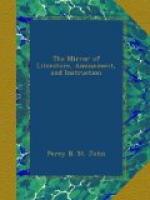La Perouse.
Before quitting Vanikoro, off which island La Perouse was wrecked, M. de Urville, captain of the Astrolabe, constructed a monument there, bearing the inscription, “To the memory of La Perouse and his companions. The Astrolabe, 14 March, 1828.” Among the relics which have been withdrawn with great difficulty from beneath the waves, are a very strong anchor, and two stout troughs.
Siberia.
Professor Hansteen and his companions were at Tobolsk, on the 12th of September, whence they travelled on sledges, the cold being at 40 degrees Reamur, so that frozen quicksilver could be cut with a knife.
The Desart.
The opinion generally formed of Desarts is completely erroneous, according to Mrs. Charles Lushington, who, in her recent Travels, says, “Though much variety of country or occurrence cannot be expected in the Desart, I may with truth assert, that the passage through it was, to me, very interesting and agreeable. For the three first stages, the road was diversified by some irregularities of ground, and remarkable passes through the rocky mountains; but the course of our journey in general, lay through an arid plain of sand and stones, about two miles in breadth, bounded by rocks of sandstone of an almost uniform appearance. On the second day’s march, I saw one or two trees, and the road was so varied, that I could then scarcely believe myself in a desart, which I had always pictured to my imagination as a dreary and interminable plain, with heavy loose sand, curled into clouds by every breath of wind.”
* * * * *
Stilts.
In south-western France, the shepherds make stilts of long poles with the thigh-bone of an ox fastened at a moderate height from the ground, as a support for the foot, and to enable them to distinguish the approach of wolves at a greater distance.
Embalming.
There are three modes of embalming among the Egyptians: one of these consists in the injection of some antiseptic drugs previous to drying the body; but the most perfect and sumptuous is thus effected: The viscera are removed, and the body sprinkled with aromatics and natron. After drying, it is enveloped in folds of gummed linen, and placed in coffins. The great principle of embalming is the exclusion of the external air, but much is attributable to antiseptics. One of the principal ingredients in the mummy balsam is colocynth, or bitter apple, powdered. The same drug is employed in Upper Egypt for destroying vermin in clothes’ presses, and store-rooms; and ostrich feathers sent to Lower Egypt are sprinkled with it. A recent traveller found in the head of a mummy, of a superior kind, a balsam, in colour and transparency like a pink topaz. It burned with a beautiful clear flame, and emitted a very fragrant odour, in which cinnamon predominated. In the heart of one of the mummies he found about three drams of pure nitre; the heart being entire, this must have been injected through the blood-vessels. Mummy powder was formerly in use all over Europe as a medicine, and is still employed as such among the Arabs, who mix it with butter, and esteem it a sovereign remedy for internal and external ulcers.




